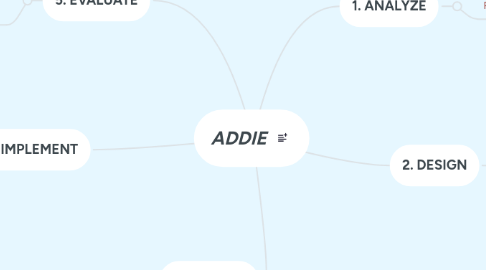
1. 1. ANALYZE
1.1. Phase used to determine needs
1.1.1. Objectives: clarify instructional problem; establish instructional goals and objectives; establish learning environment and learner's existing knowledge
1.1.1.1. Action -- Answer the Following Questions: What is the point of this training? What are the characteristics of my audience? What are new behavioral outcomes? What are the learning constraints? What is the project completion timeline? Why are we doing this? Will it help?
1.1.1.1.1. Consider Variables: include cost, schedule, requirements, and risks; Determine if it is a "go - no go."
2. 2. DESIGN
2.1. Systematic and specific design and creation phase.
2.1.1. Objectives: Identify learning objectives, assessment tools, content (text, audio, video), exercises, lesson plans and media.
2.1.1.1. Action -- Come with Course Design Overview By: Quantifying the project; Determining the costs, effort and personnel; Defining the program structure; Determining duration and pace; Definitive program format; Finalizing mode of delivery
2.1.1.1.1. Consider Variables: include cost, schedule, requirements, and risks; Determine if it is a "go - no go."
3. 3. DEVELOP
3.1. This phase is for the creation and assembling of design content.
3.1.1. Objective: To review and revise any edits, additions or omissions including those provided via feedback.
3.1.1.1. Action -- Testing the Course by: Adding additional content (fonts, graphics and colors); Thoroughly testing the course through content accuracy and navigation utility.
3.1.1.1.1. Consider Variables: include cost, schedule, requirements, and risks; Determine if it is a "go - no go."
4. 4. IMPLEMENT
4.1. This phase is the creation of procedures to train facilitators and learners.
4.1.1. Objective: Creation of a fully scalable training model that is clear and accurate.
4.1.1.1. Action: Include course curriculum; training outcomes; delivery method and testing procedures; train on the technology being used.
4.1.1.1.1. Consider Variables: include cost, schedule, requirements, and risks; Determine if it is a "go - no go."
5. 5. EVALUATE
5.1. This phase is used at all points in the project. It determines the type of project or instruction by evaluating objectives.
5.1.1. Objective: Ensure the project is meeting its objectives through routine evaluation.
5.1.1.1. Formative Evaluation: Present at each stage.
5.1.1.2. Summative Evaluation
5.1.1.2.1. Action: customize your evaluation process; test the design; leave room for user feedback;
5.1.1.3. Consider Variables: include cost, schedule, requirements, and risks; Determine if it is a "go - no go."

